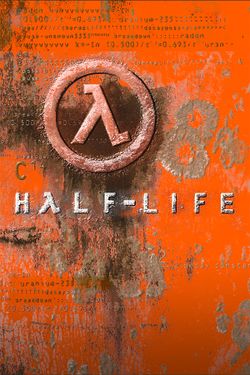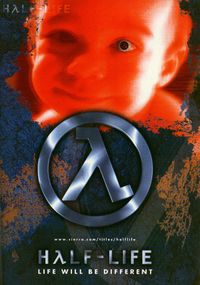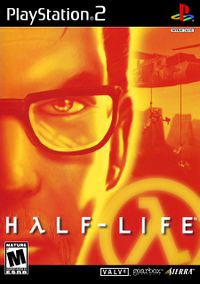Half-Life
| Внимание! Перевод этой статьи на русский язык еще не доведен до более высокого качества англоязычной статьи. | ||
|---|---|---|
Вы можете помочь проекту, исправив орфографические ошибки и адаптировав смысл слов и предложений в переводе. После завершения перевода и полноценной интеграции в навигационные шаблоны это уведомление может быть удалено. |
This article is about the first game. For the overall series, see Half-Life and Portal universe. |

| |
| Half-Life | |
|---|---|
| Разработчик(и) | |
| Дата выхода |
19 Ноября, 1998[1]
14 Ноября, 2001[2]
|
| Жанр(ы) | |
| Режим(ы) игры | |
| Платформ(ы) | |
| Возрастные огр. | |
| Метод(ы) дистрибуции |
Sierra On-Line (первоначально) |
| Сис. требования |
500 МГц процессор, 96 МБ ОЗУ и 16 МБ Видеопамяти |
| Ув-ва ввода |
Клавиатура и мышь (PC) |
| Движок | |
| Серия | |
| Сценарист(ы) | |
| Композитор(ы) | |
| Пред. в серии | |
| След. в серии | |
- "Беги. Думай. Стреляй. Живи."
- ― слоган Half-Life[src]
Half-Life — научно-фантастический шутер от первого лица, где главным героем является учёный Гордон Фримен. Разработан для персональных компьютеров компанией Valve Software на значительно переработанном движке Quake, названном GoldSrc.[6][7]
Contents
Сюжет[edit]
Основная статья: Сюжет Half-Life
Действующий персонаж Half-Life — Гордон Фримен, выпускник MIT, доктор философии (PhD) в области теоретической физики, работающий в научном комплексе «Чёрная Меза». В ходе очередного эксперимента неожиданная авария приводит к каскадному резонансу, который создает пространственный разрыв и сильно повреждает исследовательский центр. Гордон должен с боем вырваться из комплекса, который наполнен инопланетными существами из другого мира — известного как Ксен — которые телепортируются сквозь разрыв.
Действие происходит в мае 200- г. в пустынной местности штата Нью-Мексико, где расположен научно-исследовательский комплекс «Чёрная Меза»; вымышленная лаборатория, напоминающая Лос-Аламосскую национальную лабораторию и Зону 51.
Фримен пытается выбраться на поверхность и найти помощь, но скоро понимает что ему противостоят две враждующие группы: агрессивные инопланетяне и спецподразделение HECU, высланное правительством США для уничтожения всех следов инцидента — в том числе свидетелей, включая учёных и лично Фримена. По ходу игры можно заметить таинственного персонажа, известного как Джи-мен, который отслеживает действия Фримена. В итоге, с помощью выживших учёных и охранников, Гордон добирается до секретного комплекса «Лямбда», где группа учёных телепортирует его в инопланетный мир Ксен, где ему предстоит убить Нихиланта — существо, которое держит открытым межпространственный разрыв.
Сюжет Half-Life изначально создавался под впечатлением от таких компьютерных игр, как Doom и Quake (разработанные id Software), новеллой Стивена Кинга под названием Туман, и телесериалом «За гранью возможного», в частности серией «Пограничная полоса». Затем Valve наняли писателя Марка Лейдлоу, автора книг Dad's Nuke и The 37th Mandala (на русский язык не переводились), для более детального прописывания сюжета. Однако, наиболее знаменита не сама сюжетная линия, а способ ее подачи игроку.
Игра подает историю с помощью при помощи скриптовых сцен, которые встроены непосредственно в мир игры, а не проигрываются как независимые кат-сцены. Среди таких сцен есть как ключевые моменты сюжета, например каскадный резонанс, так и мелкие детали, вроде учёных убегающих от врагов. Данный стиль позволял игрокам погрузиться в игровой мир и создать непрерывное повествование от лица главного героя, что отличило Half-Life от современных ей игр и на долгие годы задало принципы в игровой индустрии.
Кроме того, Valve добавила другие особенности, которые считались способствующими погружению в игру - игрок никогда не видит и не слышит своего персонажа, и почти никогда не теряет управление над ним, даже во время монологов других персонажей. Такой подход позволял самостоятельно додумать образ Гордона, несмотря на его определённую роль в мире игры. Скриптовые сцены иногда позволяли игроку вмешаться и спасти или убить определенного персонажа по своему желанию. Уровни в Half-Life были разделены на достаточно мелкие карты, чтобы сократить время на подгрузку уровней.
Персонажи[edit]
- Gordon Freeman
- Black Mesa Scientists
- Black Mesa Security Guards
- The G-Man
- Nihilanth
- Eli Vance (Retcon)
- Gina Cross (As Holographic Assistant)
- Barney Calhoun (Cameo) (Retcon)
- Wallace Breen (Mentioned only)
Враги[edit]
Оружие[edit]
Development[edit]

Half-Life was the first product for Kirkland, Washington-based developer Valve Software, which was founded in 1996 by former Microsoft employees Mike Harrington and Gabe Newell. They settled on a concept for a horror-themed 3D action game, and licensed the Quake engine from id Software. Valve eventually modified the engine a great deal, notably adding skeletal animation and Direct3D support; a developer later stated that seventy percent of the engine code was rewritten.[8] At first, Valve had difficulties finding a publisher, many believing their project "too ambitious" for a studio headed by newcomers to the video game industry. However, Sierra On-Line had been very interested in making a 3D action game, especially one based on the Quake engine, and so signed them for a one-game deal.
The original code name for Half-Life was Quiver, after the Arrowhead military base from Stephen King's novella The Mist, which served as early inspiration for the game. Other names considered for the game included Triphammer and Belly of the Beast.[9] Gabe Newell explained in an interview that the name Half-Life was chosen because it was evocative of the theme, not clichéd, and had a corresponding visual symbol: the Greek letter lambda, which represents the decay constant in the half-life equation.
The first public appearances of Half-Life came in early 1997; it was a hit at the Electronic Entertainment Expo that year, where they primarily demonstrated the animation system and artificial intelligence. Valve Software hired science fiction author Marc Laidlaw in August 1997 to work on the game's characters, story, and level design. Half-Life was originally planned to be shipped in November 1997,[10] to compete with Quake II, but was postponed when Valve decided the game needed significant revision.
In a 2001 "Making of..." (Issue 105) feature in Edge, Newell discussed the team's early difficulties with level design. In desperation, a single level was assembled including every weapon, enemy, scripted event and level design quirk that the designers had come up with so far. This single level inspired the studio to press on with the game. As a result, the studio completely reworked the game's artificial intelligence and levels in the year leading up to its release. At E3 1998 it was given Game Critics Awards for "Best PC Game" and "Best Action Game" at the expo. The release date was delayed several times in 1998 before the game was finally released in November of that year.
Reception[edit]
The game had its first major public appearance at the 1997 Electronic Entertainment Expo, where it was widely acclaimed.
On its release, critics hailed its overall presentation and numerous scripted sequences, and it won over 50 PC Game of the Year awards.[11][12] Its gameplay influenced first-person shooters for years to come, and it has since been regarded as one of the greatest games of all time.[13] As of December 2008, Half-Life has sold 9.3 million copies.[14] As of July 14, 2006, the Half-Life franchise has sold over 20 million units.[15] According to GameSpy, Half-Life was the most played online PC game (excluding MMORPGs) as of September 2008, ahead of Half-Life 2.[16] In celebration of the game's 10th anniversary, Valve lowered the price of Half-Life from $9.99 USD to $0.98 on November 19, 2008 for three days.[17]
Сетевая игра[edit]
В игре присутствует deathmatch-режим, который обрел большую популярность у игроков и стал основой для большого числа модификаций и карт. В многопользовательском режиме изменены многие параметры оружия, например болты арбалета взрываются, а у тау-пушки увеличена отдача, и в целом процесс более динамичен чем одиночная кампания. Сетевая игра до сих пор сохраняет активность, и к 25-му юбилею Valve добавила в неё 4 новые карты и 2 модели игрока.
Портирования[edit]
После первоначального выхода на Windows, Half-Life официально портировали на PlayStation 2. Также были созданы версии для Dreamcast и Apple Macintosh, но их отменили незадолго до окончания разработки и в продаже они не появились. Кроме того, существуют неофициальные версии для Android, основанные на движке Xash3D.
Дополнения[edit]
Студия Gearbox Software выпустила три дополнения: Half-Life: Opposing Force (1999) и Half-Life: Blue Shift (2001) для ПК и Half-Life: Decay (2001) как эксклюзив для PlayStation 2. В Opposing Force игрок возвращается в Чёрную Мезу в роли одного из морских пехотинцев США, которые были врагами в оригинальном Half-Life. Дополнение добавляет несколько новых видов оружия, новых персонажей и врагов (например охранник Отис Лоури и враждебная Раса Икс), и ранее невиданные локации исследовательского комплекса. Дополнение короче чем Half-Life и имеет 11 глав по сравнению с 19 из оригинала.
Blue Shift так же возвращает игрока во время действия Half-Life, в этот раз в роли одного из охранников комплекса. Изначально дополнение создавалось как бонусная миссия для отмененной версии для Dreamcast. Blue Shift добавляет опциональный High Definition Pack который заменяет модели в Half-Life, Opposing Force и самом Blue Shift. У моделей увеличено число полигонов и размер текстур, заменены некоторые звуки, в частности выстрел дробовика. По сравнению с Opposing Force в Blue Shift было не так много нового: несколько моделей персонажей (ученые без халатов и охранники без брони, Отис, доктор Розенберг) и ещё меньшее число новых уровней.
Decay для PlayStation 2 добавил совместную игру, где два игрока долны сражаться с врагами и решать задачи в роли двух женщин-учёных, чтобы попытаться справиться с последствиями инцидента.
Продолжения[edit]
Продолжение Half-Life 2 оставалось предметом слухов до апреля 2003 года, когда несколько игровых журналов (Edge, PC Gamer, Computer Gaming World) получили первые материалы об игре. В мае 2003 года игру показали на выставке E3, взбудоражив игровое сообщество. Игрок снова играет за Гордона Фримена, на этот раз примерно через пару десятилетий после инцидента в Чёрной Мезе. Действие происходит в антиутопичном Сити 17, где Фримен становится участником сопротивления инопланетному режиму Альянса. После серии скандалов и переносов, Half-Life 2 вышла в свет 16 ноября 2004 года.
Half-Life 2: Episode One продолжает сюжетную линию, совместно с Half-Life 2: Episode Two который вышел в октябре 2007 года. Последний эпизод трилогии, который бы завершил сюжетную линию начатую в Half-Life 2, никогда не был выпущен.
Модификации[edit]
After its release, Half-Life saw fervent support from independent game developers, due in no small part to support and encouragement from Valve Software. Worldcraft, the level-design tool used during the game's development, was included with the game software. Printed materials accompanying the game indicated Worldcraft's eventual release as a retail product, but these plans never materialized. Valve also released a software development kit, enabling developers to modify the game and create mods. Both tools were significantly updated with the release of the version 1.1.0.0 patch. Many supporting tools (including texture editors, model editors, and rival level editors like the multiple engine editor QuArK) were either created or updated to work with Half-Life.
Half-Life's code has been released and is being used as a base for many multiplayer mods such as the immensely popular Counter-Strike. Other popular multiplayer mods include Team Fortress Classic, Day of Defeat, Deathmatch Classic, Action Half-Life, Firearms, and Natural Selection. Team Fortress Classic and Deathmatch Classic were both developed in-house at Valve Software. Some mods, such as Counter-Strike and Day of Defeat, that began life as the work of independent developers (self-termed "modders"), later on received aid from Valve. There was even a free team-based multiplayer mod called Underworld Bloodline created to promote the Sony Pictures film Underworld.
Numerous single-player mods have also been created, such as USS Darkstar (1999, a futuristic action-adventure on board a zoological research spaceship), The Xeno Project 1 and 2 (1999-2005, a two-part mod starting in Xen and again including spaceships), Edge of Darkness (2000, which features some unused Half-Life models), Half-Life: Redemption (1999, which brings back Gordon Freeman for four additional episodes and another encounter with the G-Man), They Hunger (2000-2001, a survival horror total conversion trilogy involving zombies), Poke 646 (2002, a follow-up to the original Half-Life story with improved graphics), Point of View, the player controls a Vortigaunt, and Half Life: Zombie Edition, where the player plays as a Headcrab).
Some Half-Life modifications eventually landed on retail shelves. Counter-Strike was the most successful, unexpectedly becoming the biggest selling online game to date and having been released in five different editions: as a standalone product (2000), as part of the Platinum Collection (2000), Counter-Strike: Condition Zero (2004), Counter-Strike: Source (2004), which runs on Half-Life 2's Source engine, and Counter-Strike: Global Offensive (2012), the newest addition to the series. Team Fortress Classic has had a visual upgrade to the Source engine, becoming the stylized Team Fortress 2. Day of Defeat also received the Source treatment, becoming Day of Defeat: Source. Gunman Chronicles (2000), (a futuristic Western movie-style total conversion with emphasis on its single-player mode) was also released as a stand-alone product.
Музыка[edit]
Музыкальный ряд Half-Life был специально записан для игры композитором Келли Бейли, который так же создал музыку для других игр серии. Кроме того, Бейли отвечал за создание остальных звуков в игре и программирование звуковой системы в целом.
Behind the scenes[edit]
Early in the game's development, the humorous idea of a food fight was proposed to occur in a cafeteria, idea eventually rejected.[18]
Trivia[edit]
- Half-Life, as well as its three expansions, are named after scientific terms. "Half-life" refers to radioactive decay.
- When Gordon puts on his hazard suit in the first level, there are two empty hazard suit slots. According to Decay developer Gearbox's CEO Randy Pitchford these belonged to (or were used by) Decay protagonists Gina Cross and Colette Green.
- Half-Life holds the record for the "Best-Selling First-Person Shooter of All Time (PC)" in the Guinness World Records Gamer's Edition 2008.
- There is a special censored German version of Half-Life.
- In the video game Payday 2, there is a Home Security Agency named “White Mesa Home Security Systems” a clear reference to Black Mesa.
Галерея[edit]
Логотипы и промо-изображения[edit]
Ранний фон главного меню, показывался на E3 1998.[19]
Главное меню[edit]
Кадры из игры[edit]
Вортигонт атакует.
Прочее[edit]
Источники[edit]
- ↑ Half-Life Released on GameSpot (November 19, 1998) (archived)
- ↑ Half-Life (2001) on PlayStation 2 on IGN (archived)
- ↑ Half-Life 1 Beta released on Steam. Retrieved on 2019-05-07.
- ↑ Half-Life 1 update released on Steam. Retrieved on 2019-05-07.
- ↑ Half-Life on the ESRB's website. Retrieved on 2020-03-05.
- ↑ Half-Life on Steam
- ↑ The Final Hours of Half-Life: Behind Closed Doors at Valve Software on GameSpot (October 19, 2004) (archived)
- ↑ PC Accelerator magazine
- ↑ The Name Game. Answers! by brettjdzn on TikTok (June 25, 2021)
- ↑ Half-Life ready to radiate at E3 on Business Wire (June 12, 1997) (archived)
- ↑ About Valve on ValveSoftware.com (archived)
- ↑ Awards and Honors on ValveSoftware.com (archived)
- ↑ The Gamasutra Quantum Leap Awards: First-Person Shooters on Gamasutra (September 1, 2006) (archived)
- ↑ Analysis: Valve's Lifetime Retail Sales For Half-Life, Counter-Strike Franchises on Gamasutra (December 3, 2008) (archived)
- ↑ Half-Life is 10 Today on Official Steam website (November 19, 2008)
- ↑ Top Game Servers By Players on GameSpy (archived)
- ↑ Half-Life decays to $1 on GameSpot (November 19, 2008) (archived)
- ↑ Half-Life 2: Raising the Bar
- ↑ E3 Report on Half-Life on Wavelength (June 25, 1998) (archived)






































